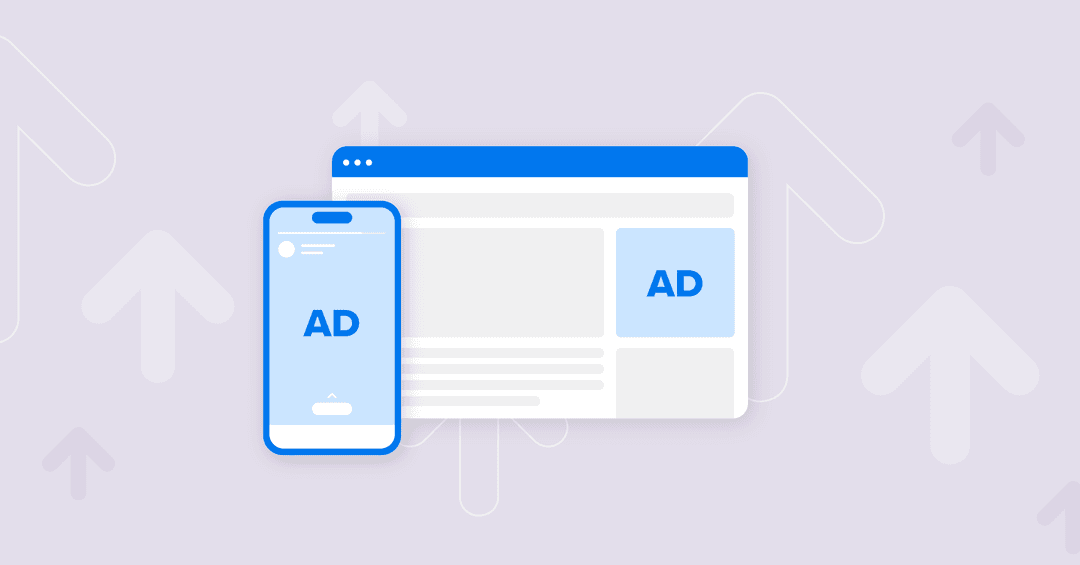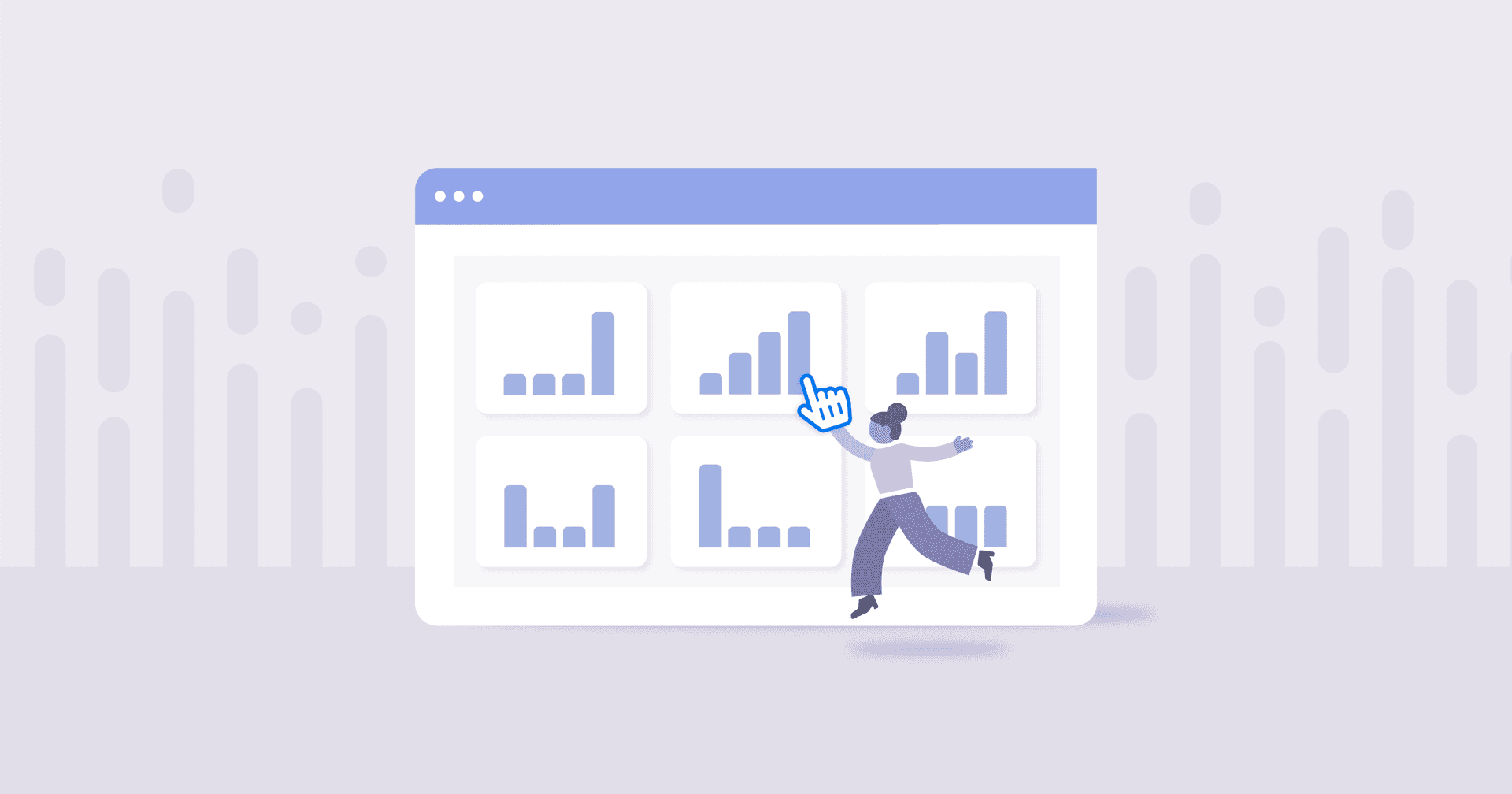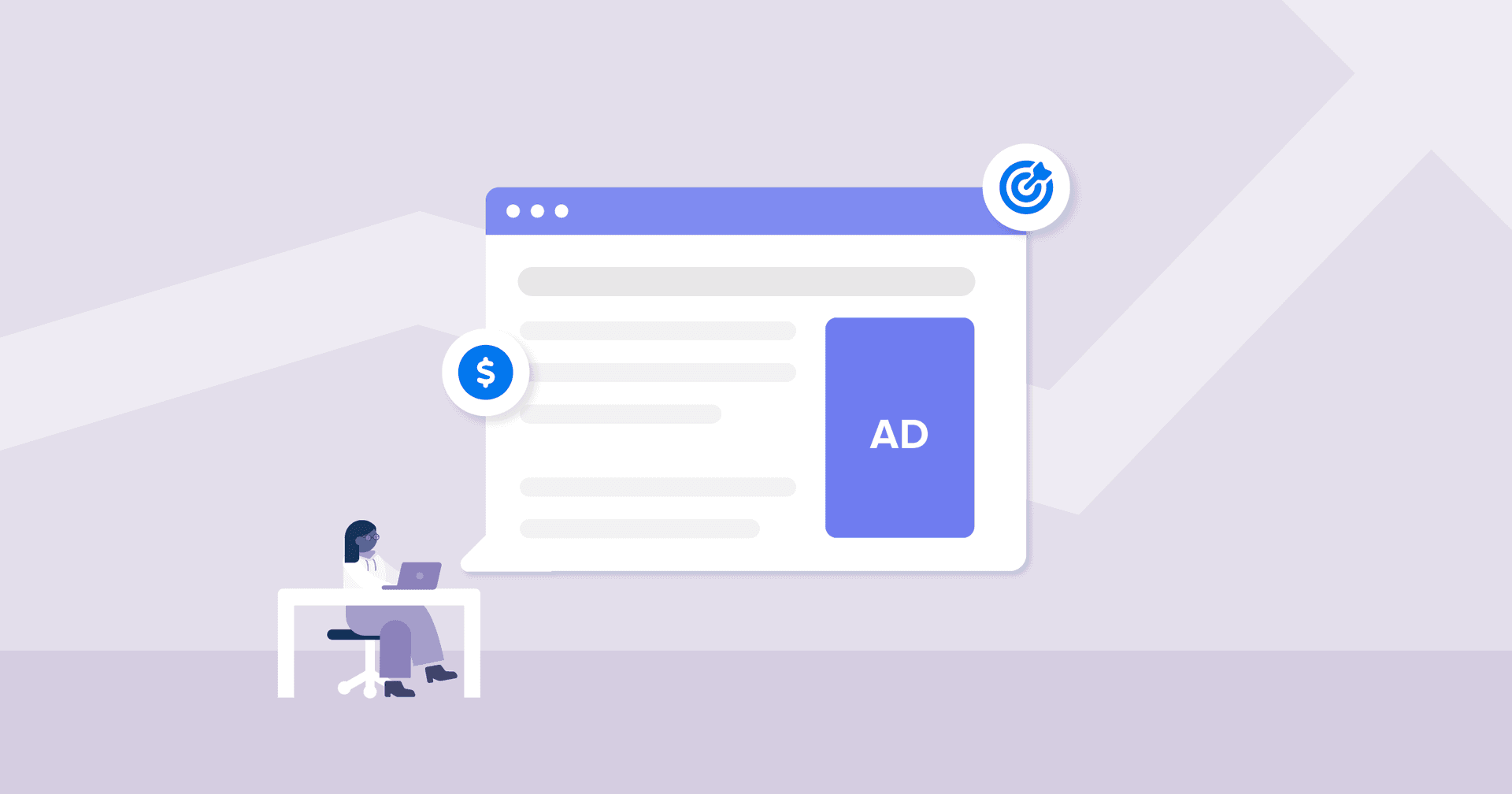Table of Contents
QUICK SUMMARY:
Remarketing is a powerful strategy that targets individuals who have already engaged with a brand. By serving tailored ads to previous visitors, it maximizes ad spend and increases conversion rates. This article by Luke Dane of Sprocket Digital outlines five proven remarketing strategies designed to increase conversions by re-engaging potential customers, reducing lost leads, and driving higher ROI.
We could kick things off by listing all the benefits of remarketing (and trust us, there’s a lot), but if you've been around the marketing block, you probably know the gist by now.
So, how about we skip the fluff and explore what happens when you neglect remarketing?
Take one of our clients for example—a big spender with a great service, a stack of leads, and an ample ad budget. They had it all except for one massive oversight: they were running the same ads for everyone.
Whether it was for first-time visitors or existing customers, they used the same old spiel. On the surface, this might not seem like a big deal, but imagine giving the exact same sales pitch to a new visitor as you would to a loyal customer.
Not only is this awkward, but it’s also a money drain. Previous customers are hotter leads, and when your client’s ads aren’t tailored to them, their budget is wasted on messaging that doesn’t hit the mark. They already know your client’s brand—they want to know why they should buy again, not hear the same tired pitch.
Fortunately, we helped them turn things around, but they’re not the only ones who’ve tripped over remarketing.
In fact, we’ve seen this scenario play out time and time again and as a result, agencies end up turning their marketing funnel into a funnel cake (i.e. a bit of a mess). That’s why today, we’re breaking down five strategies to get your remarketing campaigns right.
Why Should Agencies Care About Remarketing?
The real question isn’t why agencies should care about remarketing—it’s why they aren’t already using it.
Remarketing is hands down one of the most powerful tools in your arsenal because you’re not just targeting casual browsers—you’re going after the gold: people who’ve already engaged with your client’s brand.
As agencies, we’re constantly making high-stakes decisions, and we need to be absolutely certain that our clients see a return on their investment.
That’s what makes remarketing such a game-changer. It’s one of the most reliable and rewarding strategies out there because you’re doubling down on those who’ve already invested in your clients. You’re not just throwing money into the wind—you’re putting it where it matters, and the results speak for themselves.
Why Remarketing Works
Don’t just take our word for it—the numbers tell the story. 26% of users return to a website thanks to remarketing. That’s over a quarter of potential customers coming back for another look.
Remarketing helps businesses reconnect because these aren’t hesitant buyers—they already trust your client and know the brand delivers. Without remarketing campaigns, many of those leads could slip into the bounce-rate abyss, potentially lost forever.
Now, you might be thinking, “My clients are great at what they do. If their customers are happy, won’t they come back on their own?” And in some cases, yes—but why leave that to chance?
People are busy. Between juggling work, family, and endless to-do lists, even the most satisfied customer might forget to return. Sometimes, a well-placed remarketing ad is just the nudge they need.
Read More: 8 Agency Client Retention Strategies to Retain Clients
Stay Relevant With a Good Remarketing Strategy
Remarketing is even more important when it comes to clients with a wide range of products or services. Their customers might love what they’ve purchased, but they may not know about other offerings. Targeted remarketing campaigns will serve tailored ads to specific audiences, introducing those additional products and keeping the relationship going.
And if all that isn’t convincing enough, consider this: 79% of consumers only engage with offers that reflect their previous interactions.
People don’t like generic ads—they’re disruptive and quite frankly, annoying when you’re trying to enjoy some downtime. But because remarketing ads are tailored to a person’s needs, they’re much more likely to engage.
At the end of the day, relevance is key, and people crave a personalized approach, not some cookie-cutter pitch.
Read More: How To Create a Google Ads Report That Proves Agency ROI
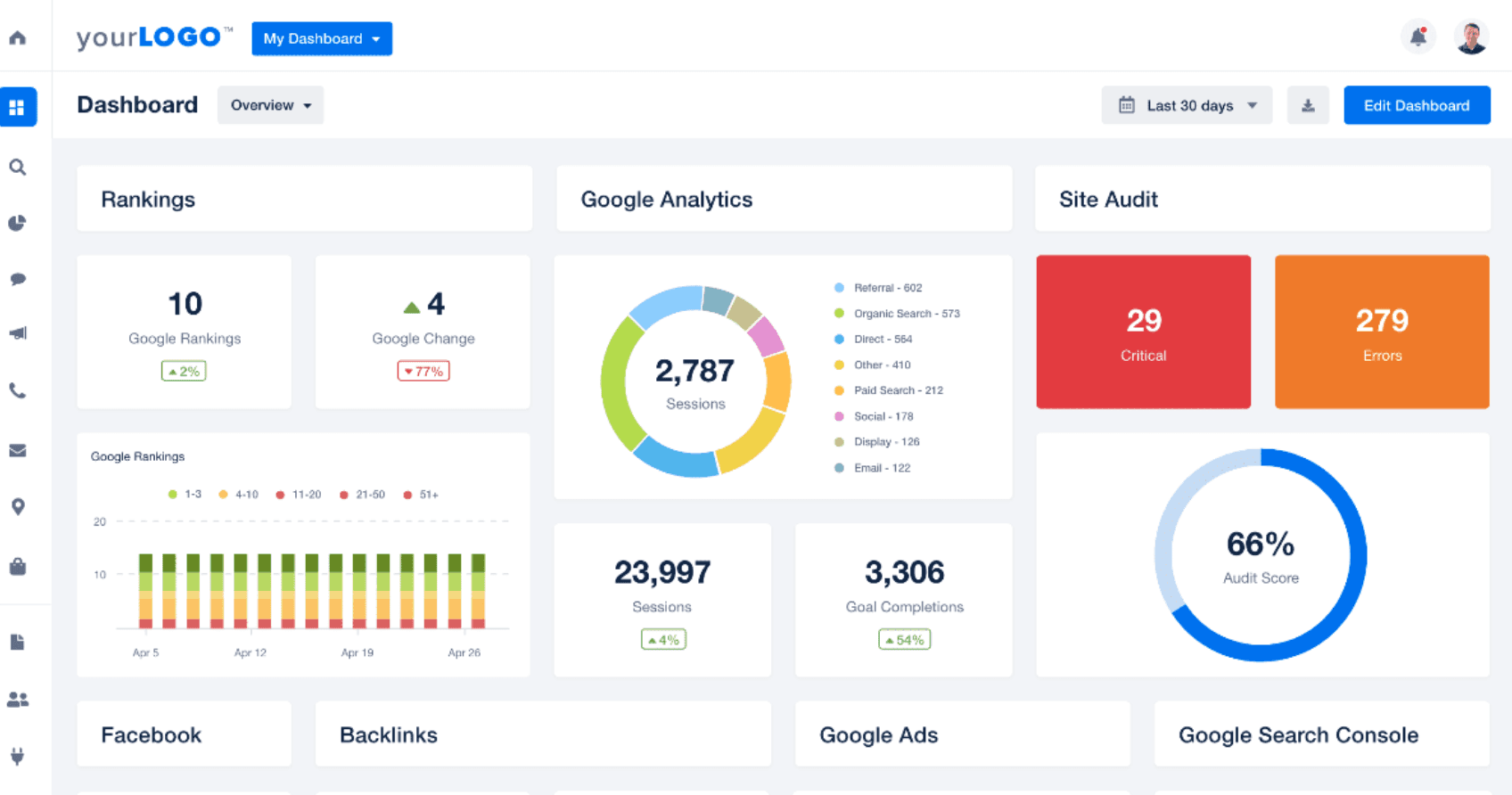
Staying relevant is easier than ever when you can create custom dashboards for each of your clients' remarketing campaigns. Track your results and stay ahead of the curve by signing up for a free 14-day trial with AgencyAnalytics.
Remarketing vs. Retargeting
You might have heard “retargeting” and “remarketing” thrown around interchangeably, but they’re not quite the same thing. Both are powerhouse strategies, yet they serve different parts of the sales funnel.
What is Retargeting?
Retargeted ads involve getting back in front of a potential customer who has already visited your client’s site but didn’t quite make it to checkout.
Think of it like this: someone checked out your client’s shop window, loved what they saw, but walked away without buying.
Retargeting lets you gently nudge these new customers or past visitors back by showing ads across the web, social media, or even in their email. Platforms like Google Ads, Facebook, and LinkedIn all have their own ways of tracking these repeat visitors (via tags, pixels, or scripts) to show them ads and, hopefully, seal the deal.
What is Remarketing?
Remarketing, on the other hand, takes a more nurturing approach. It’s about reconnecting with people who have already bought from you. Maybe they purchased something a while back, and now you want to offer them something new or give them access to an exclusive VIP sale.
This strategy will target existing customers and keep them in the loop, showing them you’re still thinking of them and that you have more value to offer.
Where retargeting is like trying to make a closing move at the bottom of the funnel, remarketing is all about nurturing customer relationships further up the funnel. It’s not just about selling once—it’s about building long-term loyalty.
In short? Retargeting brings them back. Remarketing keeps them coming back.
The 5 Different Remarketing Ad Formats
Let’s take a closer look at the different remarketing ad formats, and why an agency might choose to use each one.
Display Remarketing Ads
Display ad remarketing is one of the most popular forms, and it involves using Google Ads to target users who have already visited your client’s site. But here’s where it gets interesting: there are two other types of remarketing, standard remarketing and dynamic remarketing.
Standard display shows generic remarketing ads to users as they browse other sites in an ad network (like the Google Display Network). These ads are great for maintaining brand awareness and fostering a renewed interest. The goal here is simple: the ads remind users of your client’s business without being too specific.
Dynamic remarketing takes it a step further by personalizing your Google Ads. These ads show site visitors the exact products they viewed previously.
So if someone was eyeing a pair of shoes, a dynamic remarketing ad campaign will remind them of those shoes, making it far more likely to convert them into buyers. Dynamic remarketing is costly but highly effective for ecommerce businesses, as it delivers a tailored experience.
Search Remarketing Campaigns
Search remarketing campaigns target past customers such as those who’ve previously visited your client’s site or made purchases by showing them ads when they search for related keywords on Google.
These Google Ads appear at the top of search engine results pages (SERPs), which makes them highly visible and effective for showing ads and capturing attention—if you have the right target audience size and an ample ad spend budget.
For example, one of our clients, with 35,000 active site visitors each month, sees great success with search ads because their traffic volume is large enough to support it. When you’re dealing with big numbers, even small conversion rates and improvements will add up to significant gains.
That said, search remarketing isn’t for everyone. Like we mentioned before, It works best for businesses with a substantial audience and budget.
Why? Because if users are already searching for your client’s product or service, they likely already have intent to buy—so they may not need much extra persuasion. In some cases, it feels redundant, as these users are already on the path to conversion.
Read More: How To Ask a Client To Increase Their PPC Budget
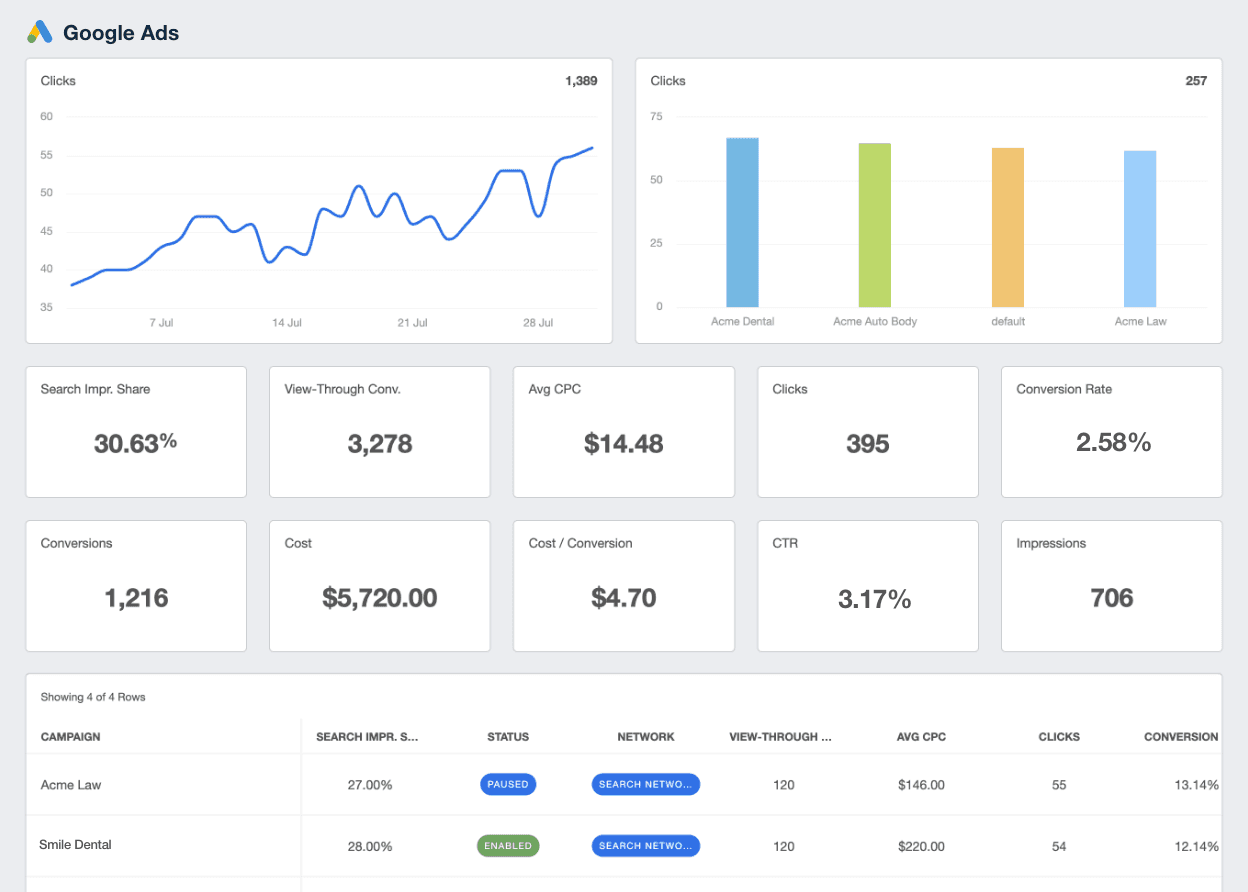
Monitor your client’s Google Ads metrics in a visual dashboard that allows you to make adjustments to their PPC strategy in real time. Try it out during your 14-day free trial of AgencyAnalytics.
Email Remarketing Ads
Email remarketing involves sending tailored messages to users who’ve engaged with your client’s business before—whether they’ve left items in their cart, made a purchase, or signed up for a newsletter.
It’s an effective way to reconnect with users by sending targeted offers, exclusive discounts, or reminders to complete a purchase.
The real power of email remarketing is its personalization. Address customers directly, send product recommendations based on their behavior, or reward loyalty. Email remarketing is perfect for boosting repeat purchases and nurturing long-term customer relationships (provided you have an effective EDM strategy!)

Connect a client’s Mailchimp account to their larger marketing dashboard in just a few clicks. Easily communicate how all of their marketing channels are working together to impact their bottom line. Start your 14-day free trial.
Social Media Remarketing Campaigns
One of the ad formats that's quickly rising in popularity is social media remarketing. Social media platforms like Facebook, Instagram, and LinkedIn offer endless flexibility for remarketing campaigns. They enable you to serve ads to users who’ve visited your client’s site, interacted with their social media content, or even engaged with specific posts.
The best part is by far the diversity. It’s possible to use a variety of different ad formats here—videos, carousel ads, stories, or simple posts—to capture attention.
Social media remarketing ads are ideal for brands with strong visual elements or businesses that thrive on direct customer engagement. This way you’ll create ads that stay visible in a space where your client’s audience spends a lot of time, making it easier to re-engage them with new products, promotions, or content.
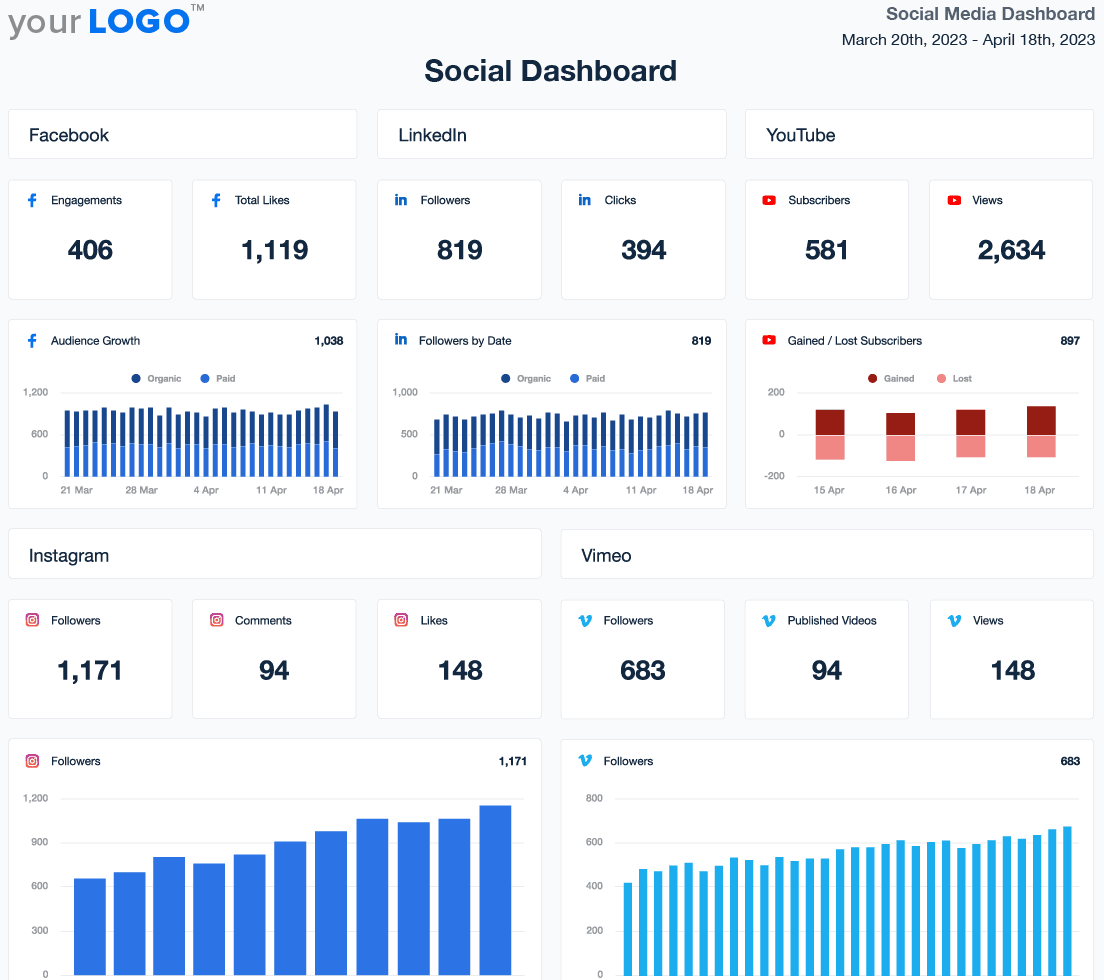
Show your clients how their audience is engaging with their social media content in an easy-to-read marketing report. Start your 14-day free trial and get access to social media report templates, automated scheduling features, and much more.
Video Remarketing Campaigns
A Video remarketing campaign involves showing video ads to users who’ve previously interacted with your client’s brand. Video ads are ideal for platforms like YouTube or when integrated within social media feeds. Video remarketing and content marketing is highly engaging, especially when done well—it’s hard to ignore a compelling story or product demo.
This type of remarketing works best for businesses that showcase their products or services visually. It’s great for building brand awareness or delivering a strong message to bring users back to your client’s site.
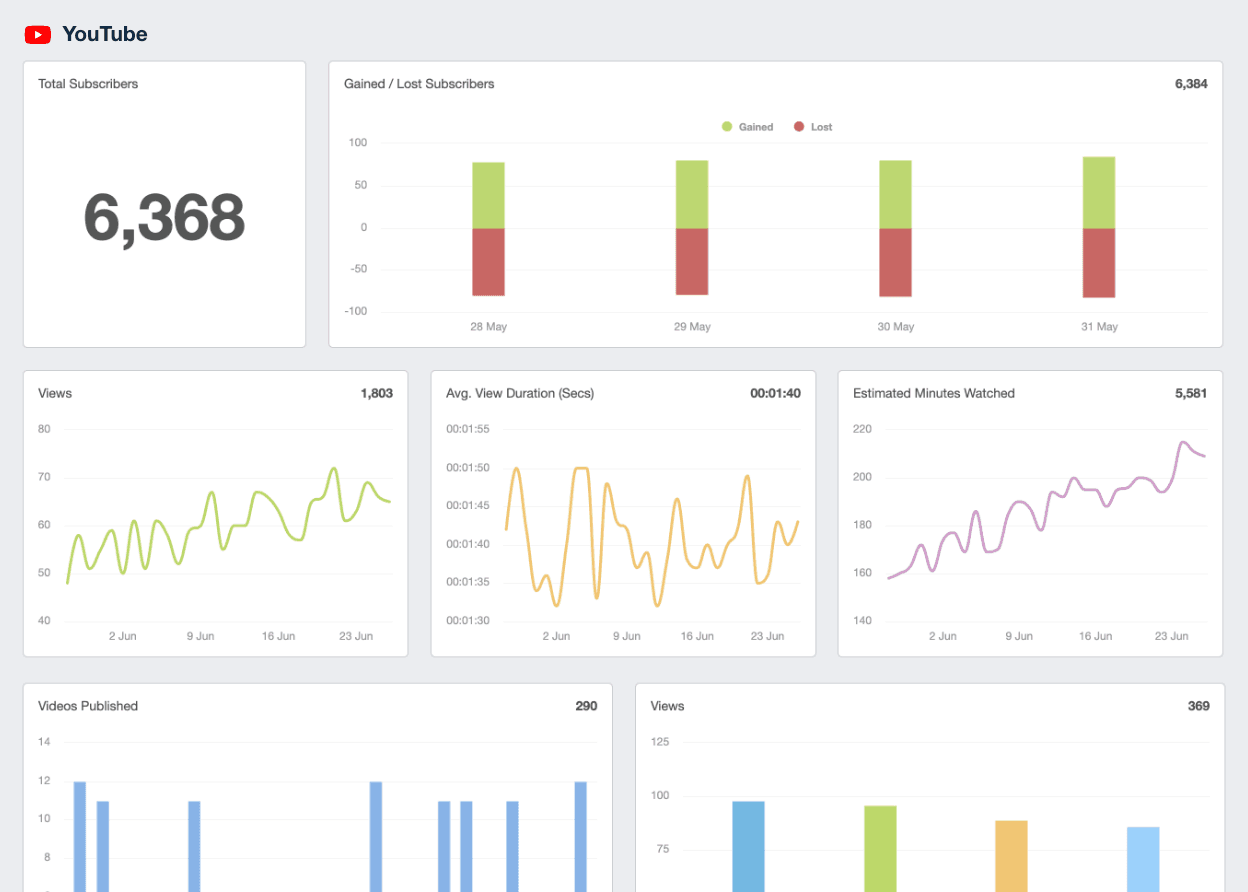
Our intuitive YouTube dashboard shows you the key metrics to evaluate your video campaign's performance in real-time. Try it out for free with a 14-day trial of AgencyAnalytics.
Our Top 5 Remarketing Campaign Strategies
At Sprocket, we’ve spent years testing a variety of remarketing strategies for clients, and we’ve arrived at some definite favorites. Let’s take a look at the strategies we’ve found most successful:
1. Timing Matters (More Than You Think!)
When it comes to creating a good remarketing campaign, the length of time your client’s tags and pixels track site visitors is crucial, and it’s not a one-size-fits-all situation.
Different industries mean different buying cycles, so the time window you set for remarketing ads should reflect how long your client’s potential customers take to make a decision.
Different Industry Timelines
Consider technology-based products and services. High-ticket items like sound systems or gaming PCs, with their many expensive components, require careful research and comparison shopping. Buyers don’t rush these decisions, which is why a 60-90-day remarketing window is ideal. This gives paying customers the time they need to consider their options without forgetting about your client.
In contrast, a homeware brand operates on a shorter timeline. Purchasing a new set of plates or a throw pillow is often a quick decision, made in days or weeks. A 30-day remarketing window makes more sense here, keeping your client top-of-mind just long enough to prompt a purchase before their ads lose relevance.
We’ve seen these differences in action. One of our clients, a rural equipment retailer, originally had their remarketing window set to 30 days. But for a farmer investing thousands in a baler, the decision process takes time. As a result, they were losing leads right when buyers were ready to convert.
After extending the window to 90 days, they saw a significant boost in conversions. By giving potential buyers the time they needed, their Google Ads remained visible at just the right moment.
2. Segmentation, Segmentation, Segmentation!
Yes, customer segmentation is such an important remarketing strategy–we had to say it thrice.
When it comes to your remarketing campaign, segmentation is everything. It’s not just about how often visitors engage with a website—it’s about understanding their behavior and creating tailored ads accordingly. How much time they spend on your client’s site, how many pages they view, and which specific pages they visit will all influence whether you take a nurturing approach or go in with a more aggressive, direct message.
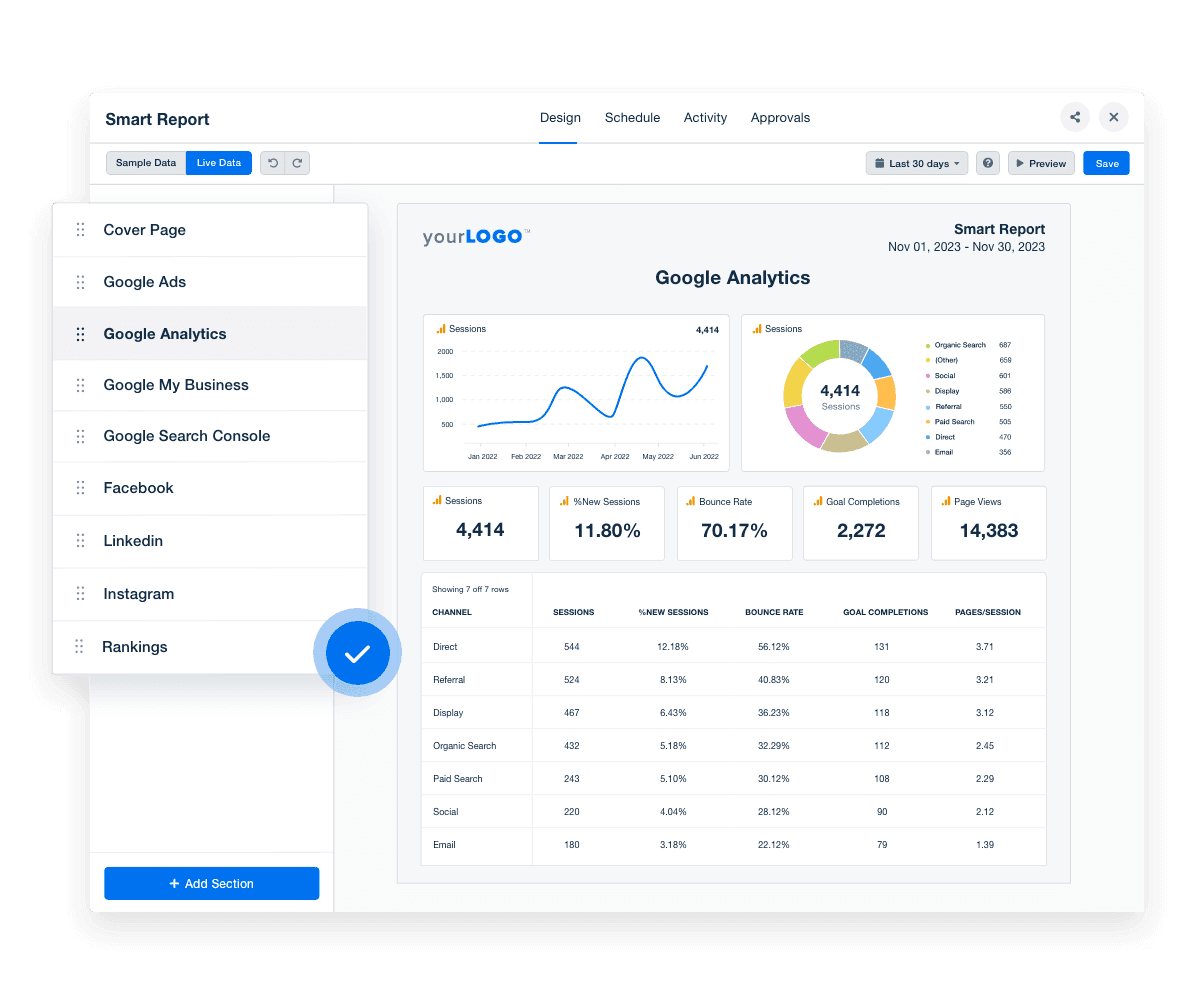
Show off your agency’s remarketing success in 11 seconds or less. With AgencyAnalytics' Smart Reports, you’ll simplify your monthly client reporting without the hassle. Try it free for 14 days!
Now, let’s take a hypothetical example: imagine you’re working with a client in the fitness industry. They sell gym equipment, supplements, and fitness gear. Their audience could be split into several key segments:
First-Time Buyers
These customers made a recent purchase, like a set of weights or a yoga mat. They’re still getting to know the brand, so remarketing ads here should focus on reinforcing trust—perhaps promoting blogs on how to use the product they just bought or introducing complementary items to encourage a second purchase.
Frequent Buyers
This group consists of loyal customers who regularly buy from the brand—think monthly orders of protein powder or new workout gear every season. For them, remarketing tactics should lean into exclusivity. Ads might highlight loyalty rewards, early access to new products, or special offers that make them feel valued.
‘Lost’ Customers
These are people who haven’t bought anything in a while. Maybe they used to be frequent buyers but drifted away. For them, you need a more enticing approach to bring them back. Targeted Ads with time-sensitive offers or incentives like “We miss you! Here’s 20% off your next order” could rekindle their interest and get them back on board.
By segmenting your remarketing strategy, you’re ensuring that each customer receives a message tailored to where they are in their journey with the brand.
It’s the difference between treating every visitor the same and making sure your clients’ ads speak to them as individuals, which ultimately leads to more conversions and better customer relationships.
Read More: Customer Journey Mapping – An Agency Guide To Creating Customer Journey Maps
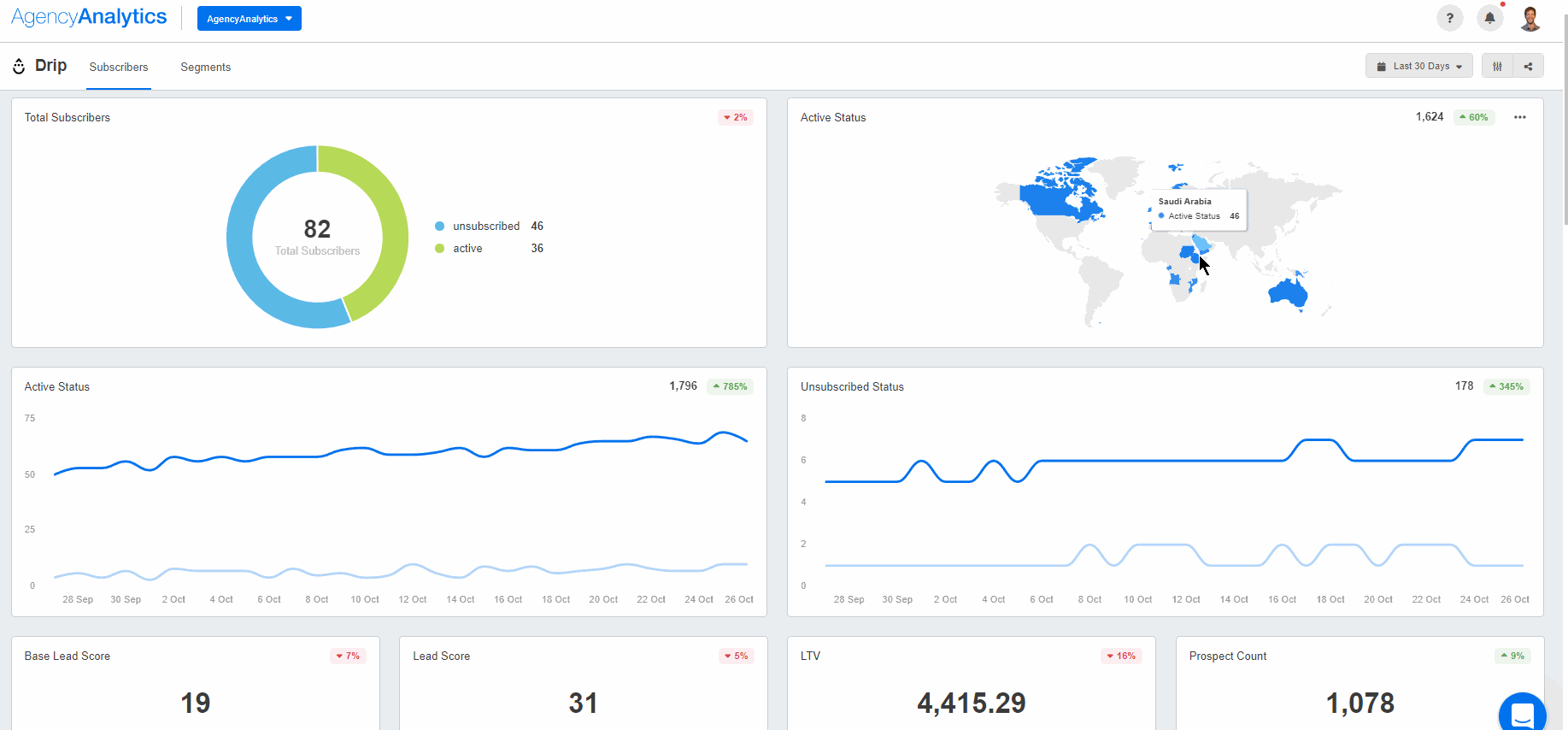
Struggling to get started with segmentation? AgencyAnalytics’ data integration capabilities make segmenting and monitoring your remarketing campaigns a breeze. Sign up for a free 14-day trial to make the most out of this strategy.
3. Email Nudges
If there’s one email remarketing campaign tactic that consistently delivers results for our clients, it’s shopping cart abandonment reminders. We include this strategy for every ecommerce client we work with—and for good reason.
The logic is simple: When someone adds an item to their cart, they’re already so close to buying. They’ve scrolled, compared, and clicked “add to cart,” meaning they’ve made a decision—they just haven't hit "buy" yet.
Read More: How to Craft the Perfect Email for Every Stage of the Buyer’s Journey
Real Results
We had a client who was skeptical about the effectiveness of cart abandonment emails. They were a mid-sized online retailer, and they thought their customers would eventually come back on their own.
But here’s what happened: As soon as we started sending automated cart abandonment reminders, their sales started rising. A well-timed message like, "Looks like you left something behind," was enough to bring customers back to complete their purchase. Add in a small incentive—like 10% off or free shipping—and those potential customers soon became buyers.
But it doesn’t stop there. We don’t just aim for that one-off conversion. We also recommend offering a discount on their next purchase through post-purchase emails.
Why? Because it’s about building customer lifetime value and loyalty and encouraging repeat business. A “Thanks for your order—here’s 10% off your next one!” goes a long way in getting customers to return.
Whether they come back to explore new products or use the discount on something they were eyeing earlier, it keeps your client’s brand at the top of their mind and encourages long-term engagement.
The best part? This strategy is consistently effective. Every client who implements it sees real, measurable results. Abandoned cart reminders help us recover sales that would otherwise be lost and turn website visitors into loyal customers who return again and again.
4. Don’t Be Stingy
It might sound controversial to invest in remarketing ads that lead to blogs, eBooks, or other "free" resources when your client’s primary goal is conversions. But here’s the thing: Your remarketing campaign shouldn't just be about getting an immediate sale.
As we mentioned before, it’s about nurturing a long-term relationship. While retargeting focuses on converting custom audiences that are close to purchasing, remarketing serves as a softer, more engaging touchpoint.
Customers appreciate a brand that offers genuine value beyond a sales pitch, and these interactions have a lasting impact. If a customer engages with a helpful or entertaining piece of content using TikTok ads for example, they’re far more likely to remember your client’s brand down the line, even if they don’t convert right away.
While providing free content might not feel as immediate as offering a discount or free shipping, it pays off in the long run.
Embracing a Long-term Strategy
For example, if a handful of website visitors take the time to read a 1,000-word blog post on "Guitar Tips for Beginners" from start to finish, it’s a pretty solid sign that they’re highly engaged and genuinely interested in buying an instrument.
This lead becomes far more valuable than someone who briefly browsed your client’s site. You’ve captured their interest, built trust, and created a foundation for a future conversion.
Most importantly: In a world bombarded with sales-heavy ad campaigns, offering content like blogs, guides, or even a fun quiz feels like a breath of fresh air. Many consumers experience ad fatigue, so offering something for free is a subtle reminder that your client’s brand values engagement and education, not just the sale. Over time, this approach builds trust, authority, and brand loyalty.
Read More: Highlight Client Success With a Content Marketing Analytics Dashboard
5. Enhance The Initial Purchase
For stores that sell a variety of items, enhancing the initial purchase through targeted upselling and cross-selling is a remarkably effective strategy.
Think of it like this: a customer just bought a shiny new smartphone—great! But that’s not the end of their buying journey. It’s an opportunity to enhance their purchase experience by offering complementary products, like a phone case or screen protector.
These add-ons are cheaper than the main item but highly relevant, providing both value to the customer and a way to increase sales.
Read More: Upselling Clients: 8 Strategies To Expand Your Accounts
Why Does This Work?
This strategy taps into something called the sunk cost fallacy. Once someone has made a significant investment—whether it's in a phone, a laptop, or even high-end kitchen appliances—they’re more likely to justify spending a bit more.
After all, if they’ve already spent $1,000 on a new phone, what’s an extra $20 or $30 for a case to protect that investment? At this point, they’re thinking, “I’ve already gone this far; I might as well make sure it’s safe.”
This mindset creates the perfect opportunity for businesses to introduce related products that offer practical benefits and complete the purchase experience.
Why Wait To Turn Potential Leads Into Loyal Customers?
At the end of the day, remarketing isn’t just about giving customers a second chance—it’s about making every interaction count.
From bringing back cart abandoners to keeping loyal customers engaged, remarketing turns potential losses into wins. Why let those customers slip away when a simple, well-timed nudge will bring them back, ready to convert?
At Sprocket Digital, we don’t just dabble in remarketing—we craft a digital marketing strategy that delivers results. Whether our clients are chasing higher conversions or aiming to build an unbreakable bond with their customers, we’ve got their back. And with our free consultations, there’s no excuse not to start.
Once your agency starts seeing results, you’ll need a way to keep track of your various types of remarketing efforts and success. AgencyAnalytics gives you real-time performance insights that make managing your remarketing campaigns a breeze. Sign up for a free 14-day trial with AgencyAnalytics today and watch your customer data transform into actionable insights.
Let’s turn browsers into buyers and make loyalty the new norm.

Written by
Luke Dane, founder of Sprocket has no shortage of experience when it comes to digital marketing. From crafting compelling email campaigns to optimizing conversions, he’s an industry expert.
See how 7,000+ marketing agencies help clients win
Free 14-day trial. No credit card required.



